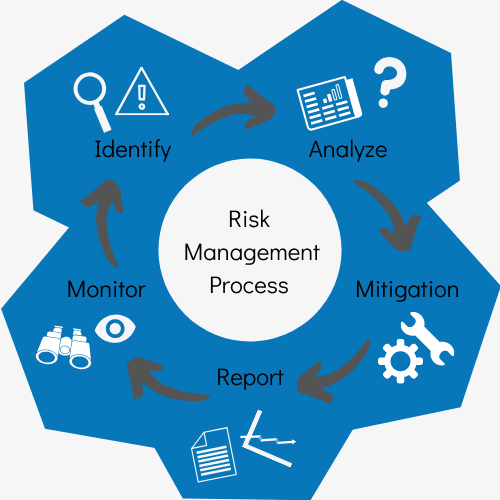Understanding the Importance of Risk Management in Modern Business Practices
Understanding the Importance of Risk Management in Modern Business Practices
Blog Article
Discovering the Relevance of Risk Management for Effective Decision-Making Approaches
In the intricate world of company, Risk Management emerges as an essential element in the decision-making process. The capability to determine potential risks and possibilities, and plan appropriately, can lead to the distinction between success and failure.
Recognizing the Idea of Risk Management
Risk Management, a vital part in decision-making, is often misconstrued or oversimplified. Usually, it describes the recognition, assessment, and prioritization of risks to reduce, check, and control the probability or impact of unfortunate occasions. It's not just about avoiding negative end results, yet additionally concerning recognizing possible chances. Risk Management includes regimented and organized techniques, using data and insightful analyses. It needs an extensive understanding of the organization's context, goals, and the possible risks that could obstruct them. From financial unpredictabilities, lawful responsibilities, critical Management errors, to crashes and natural disasters, it attends to various dangers. Significantly, reliable Risk Management is not stationary; it's a continuous, positive process that advances with altering circumstances.
The Role of Risk Management in Decision-Making Processes
In the world of critical preparation and business operations, Risk Management plays an important function in decision-making processes. Risk Management therefore comes to be an essential tool in decision-making, helping leaders to make educated options based on a thorough understanding of the risks included. Risk Management offers as an important component in the decision-making procedures of any type of company.

Exactly How Risk Management Improves Strategic Preparation
In the context of tactical preparation, Risk Management plays a crucial duty. Initiating with the recognition of prospective threats, it better includes the execution of Risk reduction measures. The role of Risk Management is dynamic yet not fixed, as it requires constant tracking and adjusting of techniques.
Recognizing Possible Risks

Carrying Out Risk Mitigation
Having developed the significance of identifying prospective threats, the following step is to discover Risk mitigation. This procedure involves establishing and applying techniques to take care of identified risks successfully. It is a crucial aspect of tactical preparation as it enhances decision-making by reducing possible negative results. Risk mitigation techniques can vary from Risk avoidance, Risk transfer, to run the risk of reduction. Each method ought to be tailored to the specific Risk, considering its prospective effect and the company's Risk tolerance. YOURURL.com Reliable Risk reduction needs a deep understanding of the Risk landscape and the prospective effect of each Risk. This understanding enables organizations to focus on dangers and allot sources efficiently, guaranteeing that one of the most substantial risks are resolved initially.
Tracking and Readjusting Strategies
Though Risk mitigation is a crucial step in critical preparation, continual surveillance and change of these methods is just as important. It additionally provides an opportunity to assess the success of the Risk Management steps, enabling adjustments to be made where required, further boosting tactical preparation. Monitoring and adjusting Risk Management techniques is a critical part for enhancing an organization's durability and calculated planning.
Case Researches: Effective Risk Management and Decision-Making
In the globe of organization and money, effective Risk Management and decision-making typically offer as the columns of thriving business. These instances highlight the value of sharp Risk Management in decision-making processes. These instances highlight the critical function of Risk Management in calculated decision-making.
Tools and Strategies for Effective Risk Management
These tools, such as Risk registers and warmth maps, aid in recognizing and examining potential check out this site dangers. Risk feedback strategies, a vital component of Risk Management, include accepting, preventing, moving, or mitigating threats. With these devices and strategies, decision-makers can navigate the complicated landscape of Risk Management, therefore assisting in notified and reliable decision-making.
Future Trends in Risk Management and Decision-Making Strategies
As we check out the vast landscape of Risk Management, it comes to be apparent that the methods and devices utilized today will certainly remain to develop. Future patterns direct in the direction of an enhanced reliance on modern technology, with fabricated knowledge and maker learning playing considerable functions. These innovations will certainly make it possible for companies to predict prospective dangers with greater precision and make even more informed decisions. Additionally, there will certainly be an expanding focus on resilience, not simply in taking care of dangers but also in recuperating from damaging scenarios. Finally, the idea of Risk culture, where every participant of an organization understands and entailed in Risk Management, will gain more prestige. These fads declare an even more comprehensive and positive approach in the direction of Risk Management and decision-making.
Final thought

Risk Management therefore ends up being an important tool in decision-making, aiding leaders to make enlightened options based on a comprehensive understanding of the threats included. Risk reduction techniques can range from Risk evasion, Risk address transfer, to take the chance of reduction (importance of risk management). Effective Risk reduction calls for a deep understanding of the Risk landscape and the possible impact of each Risk. Risk response techniques, a crucial component of Risk Management, involve accepting, preventing, moving, or mitigating risks. The principle of Risk society, where every participant of a company is conscious and included in Risk Management, will get extra prestige
Report this page